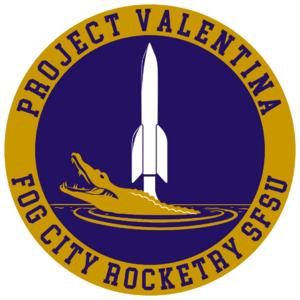Project Valentina xVLS24
The Purpose of PROJECT VALENTINA is to develop a cheap launch system based on the 41.6mm (BT-60 type) body tube rocket. All Engines used in this will have diameters of 24mm and 29mm with varying fuel types, engine ratings ranging from an Estes C11 to an AeroTech G125. The booster stage of the rockets will consist of one contiguous piece of 41.6mm diameter (BT-60 type) body tube with a length of 457.2mm (18 inches), a 24 inch shock cord with a single 24 in (Minimum diameter) parachute tied to it. The booster will have 4 variants, two with 24mm engine mounts, and two with 29mm engine mounts. These will be distinguished by designating each booster variant as E1, E2 etc. The Payload section will vary in length between 4 inches to 10 inches in body tube usage. This payload section is also meant to completely separate from the booster at the separation event near apogee. The only thing really consistent with every payload section is that every payload section will have a 6 in shock cord with a 15 in (Minimum Diameter) parachute attached to the lower bulkhead with an eyebolt and each payload section will be tipped with a NC-60 Nose Cone. Everything else in the Payload section is Mission Specific. This is the essence of the Valentina Launch System. Primary Target altitude is from 500ft to 3500ft. MAX service ceiling should be 4000 ft. The Valentina Launch System is meant to be versatile and its boosters reusable. The payload sections could be modified and specifically tailored to a specific mission profile. Anything from Parachute tests to Atmospheric Research and Avionics Stress Tests and more.
Codename Origin
The namesake of the codename "VALENTINA" is Valentina Tereshkova who was the first woman in space.
Budget
The budget for the project was initially projected to be 160 USD. The total cost ended up being 297.66 USD including shipping and taxes. We went 137.66 USD overbudget.
Specifications
These specifications are for the booster variants of Project Valentina.
| Variant Type | Manufacturer | Booster Length | Diameter(Outer) | Motor Mount Type | Recovery System | Fins | Engine Compatibility |
|---|---|---|---|---|---|---|---|
| xVLS24 A1 Valentina | Fog City Rocketry SFSU | 457.2mm | 41.6mm | 24mm x 70mm | 2 Parachutes (one for booster, one for payload bay) | 3 Balsa Wood Fins | Estes C11/D12 |
| xVLS24 A2 Valentina | Fog City Rocketry SFSU | 457.2mm | 41.6mm | 24mm x 95mm | 2 Parachutes (one for booster, one for payload bay) | 3 Balsa Wood Fins | AeroTech E20, E30, F30, F44, F32 |
| xVLS24 A3 Valentina | Fog City Rocketry SFSU | 457.2mm | 41.6mm | 29mm x 177.8mm | 2 Parachutes (one for booster, one for payload bay) | 3 Balsa Wood Fins | AeroTech G38, G40, G77, G125, G72, G75
Enerjet E20-4W, E30-4T, F44-4W, F67-6W, G74-6W, G74-9W, G80-10T |
Test Flights
At the time of writing, the xVLS24-A1 was test flown. The other two variants will need to be
| Variant Type | Manufacturer | Booster Length | Diameter(Outer) | Motor Mount Type | Date Flown | Engine Used | General Notes |
|---|---|---|---|---|---|---|---|
| xVLS24 A1 Valentina | Fog City Rocketry SFSU | 457.2mm | 41.6mm | 24mm x 70mm | October 25th 2024
16:20 hours, Lot 25 |
C11-7 | General success and flyable. Will recommend the use of Estes D12 engines or the A2 variant booster for heavy payloads (over 35 grams).
-- Eshton L. |
| xVLS24 A2 Valentina | Fog City Rocketry SFSU | 457.2mm | 41.6mm | 24mm x 95mm | N/A | N/A | N/A |
| xVLS24 A3 Valentina | Fog City Rocketry SFSU | 457.2mm | 41.6mm | 29mm x 177.8mm | N/A | N/A | N/A |
Future proposed variants
There is speculation as to whether a full fiberglass variant of the Valentina Launch System will be built. However, any new variant will deviate from the already established diameter standard of 41.6mm. Most likely this new series of vehicles will have a 54mm diameter vehicle with a 600mm booster length and a designation of "xVLS24M".
